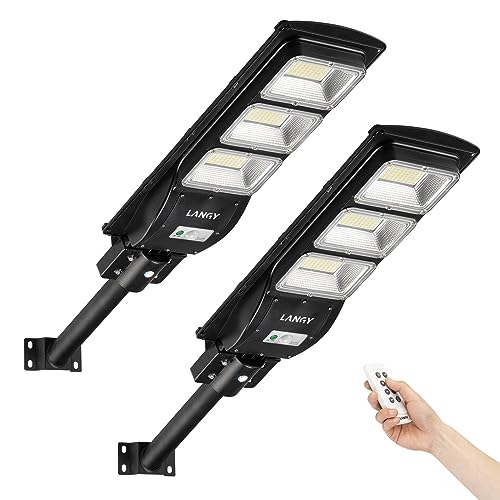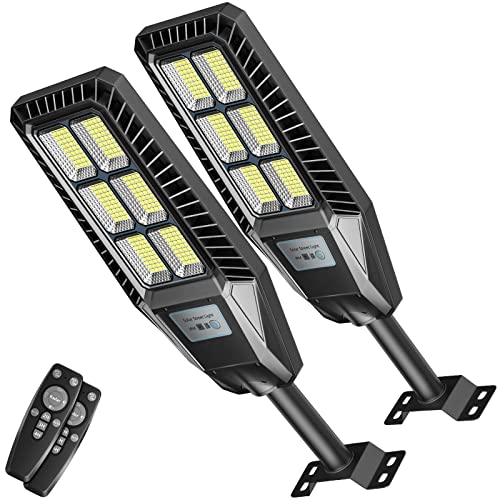Welcome to our blog, where we strive to bring you the latest insights and discoveries that can make a positive impact on our world. Today, we want to shed light on a topic that not only benefits us but also our planet: solar-powered streetlights. In this post, we will explore the advantages of this innovative technology and how it can create safer and more sustainable communities. Join us as we delve into the exciting world of solar-powered streetlights and discover the numerous benefits they offer.
Eco-Friendly Illumination: Top-selling solar-powered streetlights
What are Solar-powered Streetlights?
As the world makes steady progress towards sustainable solutions, solar-powered streetlights have emerged as an innovative way to light up our streets while minimizing our impact on the environment. By harnessing the power of the sun, these streetlights offer a renewable energy alternative that is both cost-effective and efficient. In this blog post, we will delve deeper into the workings of solar-powered streetlights and highlight their numerous benefits.
How Solar-Powered Streetlights Work
Solar-powered streetlights operate by utilizing photovoltaic (PV) panels, also known as solar panels, to convert sunlight into electricity. The panels are typically mounted on top of the streetlight poles or on nearby structures, ensuring maximum exposure to sunlight throughout the day. Here’s a breakdown of their functioning:
- Photovoltaic panels absorb sunlight: Solar panels consist of numerous photovoltaic cells made from semiconductor materials. These cells absorb sunlight and generate direct current (DC) electricity.
- Conversion of DC to AC electricity: The DC electricity generated by the solar panels is fed into an inverter, which converts it to alternating current (AC) electricity, suitable for powering the streetlights.
- Charging the battery: A rechargeable battery, usually located at the base of the streetlight pole, stores the excess electricity generated during the day. This stored energy is used to power the streetlights during the night, ensuring uninterrupted illumination.
- Intelligent controls: Solar-powered streetlights often feature intelligent controls that adjust their brightness levels based on ambient light conditions. This not only conserves energy but also ensures optimal lighting throughout the night.
Benefits of Solar-Powered Streetlights
1. Energy efficiency: Solar-powered streetlights are highly efficient, converting sunlight into electricity with minimal losses. They make effective use of renewable solar energy, reducing dependence on conventional power sources.
2. Cost-effective: While the initial installation cost of solar streetlights may be higher than traditional streetlights, they offer significant savings in the long run. Solar-powered streetlights eliminate the need for electricity bills, bringing down operational costs and providing better return on investment.
3. Environmentally friendly: By relying on clean and renewable energy, solar-powered streetlights contribute to reducing carbon emissions and combating climate change. They help in creating greener, more sustainable environments.
4. Easy installation and maintenance: Solar-powered streetlights can be installed in remote areas or locations without easy access to the electricity grid. Their standalone nature eliminates the need for underground cabling, resulting in faster and more cost-effective installation. Moreover, they require minimal maintenance, with the most critical maintenance task being cleaning the solar panels periodically.
5. Improved safety and reliability: Solar-powered streetlights offer reliable lighting solutions even during power outages. This ensures continued safety and security for pedestrians and vehicles at all times.
Advantages of Solar-powered Streetlights
Solar-powered streetlights have gained popularity in recent years due to their numerous advantages over traditional grid-powered streetlights. In this blog post, we will explore the various benefits of solar-powered streetlights, from reducing electricity costs to promoting sustainability and resilience.
1. Cost Savings
One of the primary advantages of solar-powered streetlights is the significant cost savings they offer. By harnessing energy from the sun, these streetlights operate on renewable energy, eliminating the need for electricity from the grid. This results in substantial reductions in electricity bills, especially for municipalities or organizations managing large street lighting networks.
2. Environmental Sustainability
Solar-powered streetlights play a crucial role in reducing carbon emissions and promoting environmental sustainability. Unlike conventional streetlights that rely on fossil fuel-based electricity, solar-powered streetlights generate clean energy from the sun. By utilizing this renewable energy source, they effectively decrease carbon footprints, contributing positively to mitigating climate change.
3. Energy Independence
One of the standout advantages of solar-powered streetlights is their ability to function independently from the grid. This ensures uninterrupted lighting even during power outages or grid failures, providing enhanced safety and security for pedestrians and drivers. Solar-powered streetlights store excess energy generated during the day in batteries, which power the lights during nighttime. This self-sufficiency makes them a reliable lighting solution in areas where power supply is unreliable or nonexistent.
4. Flexibility and Easy Installation
Solar-powered streetlights are highly flexible and do not require extensive wiring or infrastructure. With no need to connect to the electric grid, they can be easily installed in various locations, such as remote areas or places with complex terrains. Moreover, their modular design allows for scalability, making it simple to add or remove lights based on changing needs or expanding road networks.
5. Long-term Durability and Low Maintenance
Solar-powered streetlights are designed to withstand harsh weather conditions and have long operational lifespans. Built with durable materials, they require minimal maintenance compared to conventional streetlights. This means fewer maintenance costs and reduced downtime for repairs or replacements, resulting in significant long-term savings for municipalities and organizations.
A quick comparison: Traditional Grid-powered vs. Solar-powered Streetlights
To better understand the advantages offered by solar-powered streetlights, here’s a quick comparison:
| Traditional Grid-powered Streetlights | Solar-powered Streetlights | |
|---|---|---|
| Electricity Costs | High | Low |
| Carbon Emissions | High | Low |
| Energy Dependence | Grid-reliant | Independent |
| Resilience during Power Outages | Non-functional | Uninterrupted Lighting |
| Installation Flexibility | Limited | Highly Flexible |
| Maintenance and Durability | High | Low |
In conclusion, solar-powered streetlights offer a range of advantages that make them a compelling choice for lighting public areas. From cost savings and environmental benefits to energy independence and easy installation, these streetlights are an effective and sustainable solution. By adopting solar-powered streetlights, cities and organizations can contribute to a greener future while ensuring safer and more reliable lighting for their communities.
Cost Savings and Environmental Benefits
Solar-powered streetlights are a sustainable and cost-effective solution for outdoor lighting. By harnessing the power of the sun, these lights eliminate the need for extensive underground wiring and significantly reduce maintenance costs compared to traditional streetlights. In addition to the financial savings, solar-powered streetlights also contribute to a greener environment by reducing reliance on fossil fuels and minimizing light pollution.
Cost Savings
Elimination of Underground Wiring
- Unlike traditional streetlights that require extensive underground wiring, solar-powered streetlights operate independently, making them easier and cheaper to install in various locations.
- By eliminating the need for trenching and connecting to the grid, solar-powered streetlights save on labor and materials costs associated with extensive wiring.
Reduction in Energy Costs
- Solar-powered streetlights utilize renewable solar energy, reducing or even eliminating electricity bills altogether.
- Traditional streetlights rely on fossil fuel-generated electricity, which comes with ongoing costs that can be substantial over time.
Minimal Maintenance Costs
- Solar-powered streetlights have fewer mechanical components compared to traditional streetlights, reducing the risk of failure and the need for repairs.
- With no reliance on electrical grid connections, maintenance requirements are minimal, resulting in cost savings over the lifespan of the lights.
Environmental Benefits
Reduced Reliance on Fossil Fuels
- Solar-powered streetlights use clean and renewable solar energy, decreasing reliance on fossil fuels.
- By reducing the demand for electricity produced from fossil fuels, solar streetlights help combat climate change and reduce greenhouse gas emissions.
Minimized Light Pollution
- Traditional streetlights often emit light in all directions, contributing to light pollution that affects wildlife and disrupts the natural circadian rhythms of humans.
- Solar-powered streetlights can be designed with directional lighting, minimizing light pollution and ensuring that light is only directed where it is needed.
Conservation of Natural Resources
- Solar-powered streetlights generate electricity from the sun’s rays, a resource that is abundantly available and free.
- By utilizing this renewable resource, solar-powered streetlights help conserve finite fossil fuel resources and reduce the environmental impact associated with their extraction and use.
Promotion of Sustainable Lighting Practices
- Deploying solar-powered streetlights demonstrates a commitment to incorporating sustainable and environmentally friendly technologies into community infrastructure.
- By setting an example, communities can inspire and encourage individuals and businesses to adopt eco-friendly practices and contribute to a greener future.
To summarize, solar-powered streetlights offer significant cost savings by eliminating the need for underground wiring, reducing energy costs, and minimizing maintenance expenses. Additionally, these lights contribute to a greener environment by reducing reliance on fossil fuels, minimizing light pollution, conserving natural resources, and promoting sustainable practices. By embracing solar-powered streetlights, communities can experience financial benefits while making a positive impact on the environment.
Factors to Consider and Implementation
Solar-powered streetlights offer a sustainable and cost-effective solution for illuminating public spaces. However, before implementing such a system, it is crucial to carefully evaluate certain factors to ensure its effectiveness and longevity. In this article, we will discuss the key considerations and provide valuable insights to help you make an informed decision.
Evaluating Local Weather Conditions
The local weather conditions play a significant role in determining the performance of solar-powered streetlights. Here are some factors to consider:
- Sunlight Availability: Evaluate the average number of sunny days in your area. More sunlight will result in increased energy production, allowing the streetlights to operate optimally.
- Cloud Cover: Assess the frequency and duration of cloudy days. Cloud cover can reduce the efficiency of solar panels and impact the overall performance of the streetlight system.
- Extreme Weather Events: Consider the occurrence of extreme weather events such as storms, hurricanes, or heavy snowfall. Ensure that the streetlights and their components are designed to withstand such conditions.
Assessing Available Sunlight
To maximize the efficiency of solar-powered streetlights, it is important to assess the available sunlight at the proposed installation sites. Here’s what you need to consider:
- Shade Analysis: Conduct a shade analysis to identify any potential obstructions that may block sunlight, such as nearby buildings, trees, or other structures. Installing streetlights in areas with minimal shading will ensure maximum exposure to sunlight.
- Orientation: Determine the optimal orientation of the solar panels on the streetlights to receive the maximum amount of sunlight. Factors such as the location’s latitude and the path of the sun throughout the day should be taken into account.
Initial Investment Required
Before implementing solar-powered streetlights, it is essential to evaluate the initial investment required. While solar-powered systems have long-term cost benefits, the upfront costs can vary based on several factors, including:
- Number of Streetlights: Determine the number of streetlights needed for your project. The larger the installation, the more costly it may be initially.
- Energy Storage Capacity: Assess the required energy storage capacity to ensure uninterrupted operation during periods of low sunlight. The size and quality of the battery bank will impact the overall cost.
- Lighting Quality and Features: Consider the desired lighting quality and additional features such as motion sensors, dimming capabilities, or remote monitoring. These factors can influence the cost of the streetlights.
Importance of Proper Installation and Maintenance
Proper installation and ongoing maintenance are essential for the long-term performance and longevity of solar-powered streetlights. Some crucial aspects to focus on include:
- Expert Installation: Ensure that the streetlights are installed by experienced professionals who understand the best practices for solar lighting systems. Proper installation ensures optimal performance and compliance with safety standards.
- Regular Cleaning: Maintain the cleanliness of the solar panels to ensure maximum energy absorption. Regular cleaning can prevent dust, debris, and other contaminants from obstructing sunlight.
- Battery Maintenance: Regularly monitor and maintain the batteries to prolong their life and ensure reliable operation. This includes checking for corrosion, inspecting connections, and replacing worn-out batteries as necessary.
Highlighting the benefits and future potential of solar-powered streetlights
In conclusion, we have explored the advantages of solar-powered streetlights and found that they present a multitude of benefits. Not only do they provide cost savings by reducing electricity bills, but they also contribute to a cleaner and healthier environment by reducing carbon emissions and reliance on fossil fuels. Additionally, solar-powered streetlights offer resilience by functioning independently during power outages, ensuring that communities remain safe and well-lit. With the growing focus on sustainability and energy efficiency, adopting solar-powered streetlights is a wise and commendable choice for both urban and rural areas. By embracing this technology, we can contribute to a greener future while enjoying the benefits of reliable and efficient street lighting.


















